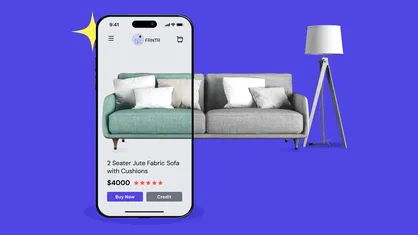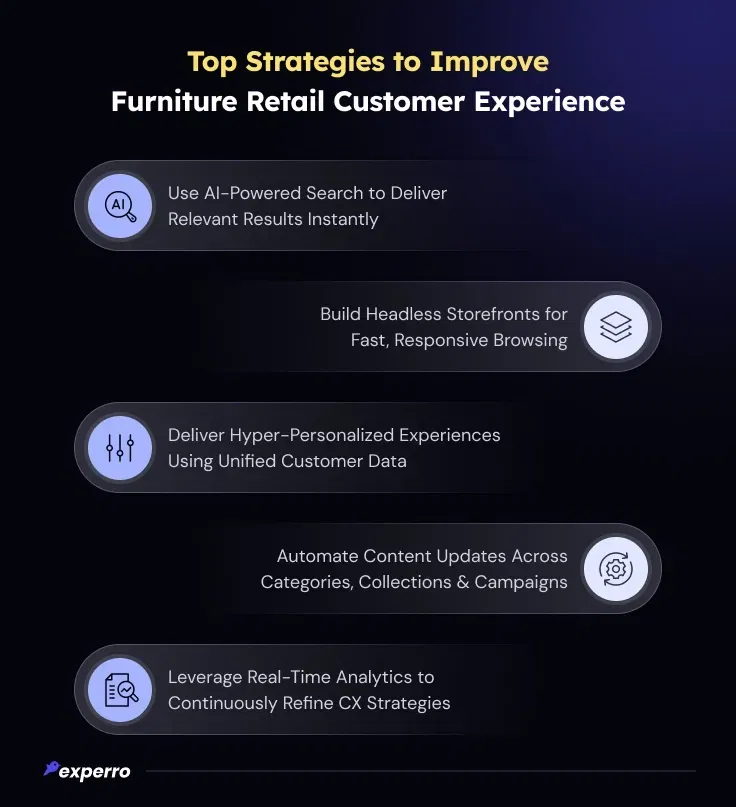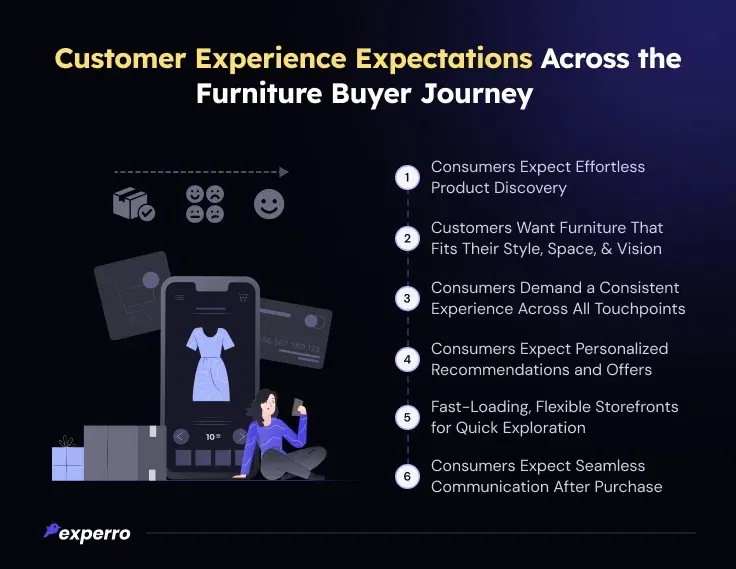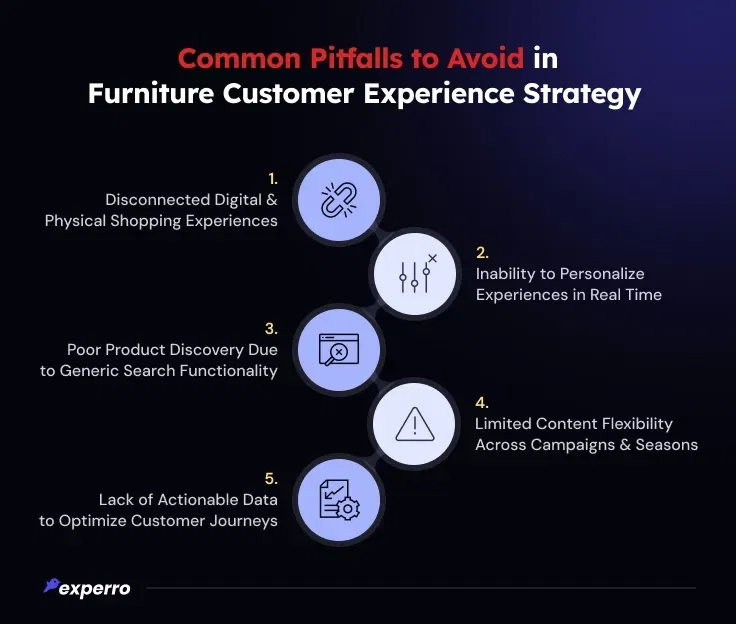- Blog
- Agentic Experience
- Generative AI
- eCommerce
- 9 min read
5 Strategies to Improve Furniture Retail Customer Experience
Published
29 April 2025Updated
2 September 2025

Key Takeaways
- A great furniture retail customer experience begins with intuitive discovery, smart filters, and relevant suggestions guide shoppers.
- Real-time personalization fosters engagement by delivering tailored recommendations based on shopper behavior.
- Consistency across online and offline experiences is key to building trust and reducing friction.
- Experro powers furniture retail transformation by offering an AI-driven, headless platform for fast, personalized, and flexible online shopping experiences.
Furniture retail is transforming. You should fear if you are not transforming your customer experience strategy.
The furniture shopping experience has evolved far beyond walking into a store and browsing through interactive displays.
Today, customers envision more—speed, personalization, and seamless transitions between online and offline touchpoints.
If your furniture retail business isn’t meeting these expectations, you’re already a step behind. With AI, automation, and omnichannel strategies, the future of furniture retail is about creating meaningful connections, not just making sales.
So, what does it really take to create a great furniture retail customer experience?
Let’s explore.
What Defines a Great Customer Experience in Furniture Retail?
A great furniture retail CX puts the customer at the center of every interaction. Every step should be smooth, from discovering the perfect sofa to receiving timely delivery updates.
Furniture eCommerce sites are not just about appealing visuals but also about solving customer problems effortlessly. Real-time personalization, intuitive navigation, and engaging content are key.
Whether it's a furniture showroom experience or a digital platform, the focus should be on creating trust. That’s the difference between a mere transaction and customer loyalty.
Peek Into Smarter Furniture Retail Statistics
To understand why furniture retail customer experience is more important than ever, let’s look at the numbers shaping the future of furniture retail:
- 70% of furniture shoppers begin their journey online, underscoring the necessity for a seamless digital experience.
- Online furniture sales are projected to reach $87 billion by 2025 in the U.S., highlighting the growing importance of eCommerce in the industry.
- 31% of U.S. shoppers purchase household furniture online on a monthly basis, reflecting the growing trend of eCommerce in the furniture sector.
Now that we have explored the statistics behind the furniture retail businesses, here are the strategies to meet the customer’s experience expectations.
Strategies to Improve Furniture Retail Customer Expectations
You now know the gaps and customer expectations. Here’s how to address them with the right furniture strategy for omnichannel retail.

1. Use AI-Powered Search to Deliver Relevant Results Instantly
Upgrade your furniture retail search with AI as it enables fuzzy search that further understands synonyms, typos, and shopper intent. This can power better furniture retail product discovery.
AI search also drives visual search in furniture retail websites, where users upload photos to find similar items. It can turn frustration into inspiration.
2. Build Headless Storefronts for Fast, Responsive Browsing
Headless architecture separates the backend from the frontend. This allows lightning-fast performance and design freedom.
It is ideal for launching seasonal layouts and campaign-specific pages. It's how top retailers adapt to trends quickly and improve furniture site search experiences. A must for any furniture retail AI platform.
3. Deliver Hyper-Personalized Experiences Using Unified Customer Data
Consolidate customer data for real-time insights. This helps craft the hyper-personalized shopping experience for furniture shoppers.
This data can be used to encourage customers and suggest complementary products or notify them when items go on sale. This is where furniture recommendation engine technology plays a big role.
4. Automate Content Updates Across Categories, Collections & Campaigns
Manual updates are slow and error prone. Various techniques of eCommerce automation can help push changes across your site in seconds.
For instance, do you want to promote eco-friendly furniture this month? Done. How?
AI workforce enables automation that drives content agility—crucial for furniture store digital transformation. It also aligns your furniture retail omnichannel strategy.
5. Leverage Real-Time Analytics to Continuously Refine CX Strategies
Data is your compass. You can see what works and what doesn’t with the right tools. From bounce rates to add-to-cart actions, real-time dashboards show you the truth.
You can refine your furniture retail customer experience strategies without guesswork. This makes your CX smarter over time.
Now, let’s jump into what customers really expect across their shopping journey.
What Are the Customer Expectations During the Furniture Shopping Journey?
It’s about adapting to what the modern buyers want. And these expectations span the full seamless furniture shopping journey.

Here’s what consumers expect today:
1. Consumers Expect Effortless Product Discovery
Buyers want to find the right product in seconds, not minutes. AI-powered furniture site search optimization understands context.
A search for “cozy reading chair” should show more than random results. It should showcase styles that match comfort and function. Over time, AI agents learn from user’s search each shopper’s behavior to make discovery even smarter and fast.
2. Customers Want Furniture That Fits Their Style, Space, and Vision
Visual content plays a huge role in interactive furniture shopping. Customers want to visualize how a product fits into their space. Dynamic layouts, 3D views, and lifestyle images help here.
Digital merchandising should reflect real homes, not artificial spaces. Personalized visuals aligned with user style enhance personalized furniture shopping.
3. Consumers Demand a Consistent Experience Across All Touchpoints
Whether a shopper browses on a laptop, mobile app, or kiosk screen, the experience should feel the same. Furniture omnichannel eCommerce strategy is key.
From cart data to product suggestions, consistency builds confidence. This also improves the online furniture shopping experience, especially when shoppers revisit across devices.
4. Consumers Expect Personalized Recommendations and Offers
Today’s buyers expect brands to “get them” (understand them). From color preferences to browsing habits, personalization drives relevance.
AI-driven platforms deliver furniture eCommerce personalization in real time, that means curated offers, style matches, and alerts for back-in-stock favorites. It’s how digital agents for furniture e-store build better customer engagement.
5. Fast-Loading, Flexible Storefronts for Quick Exploration
Speed matters. Shoppers won’t wait for slow pages to load. Headless setups allow flexible, fast-loading storefronts.
This is core to all agentic eCommerce platforms for furniture brands. Snappy (fast and smooth) performance means more product views, less bounce, and more conversions. Great CX starts with speed.
6. Consumers Expect Seamless Communication After Purchase
Customer experience doesn’t end after checkout. Post-purchase care is an extended part of the furniture store customer experience. Automated order updates, delivery tracking, and easy returns build customer confidence and trust.
AI-enabled tools can answer questions 24x7. These AI shopping assistants for furniture make support seamless and proactive.
This section covers all the customer expectations across their buying journey.
Now, let’s learn more about the obstacles in following the customer experience tactics and how your business can avoid them.
Power your online furniture sale with Experro’s customer-first experience!
Customer Experience Strategy Red Flags – What Furniture Retailers Must Avoid?
Many furniture retailers fall into common customer experience traps. These not only frustrate customers but hurt long-term growth.

Let’s uncover the red flags that hold back the furniture store customer experience from being better.
1. Disconnected Digital and Physical Shopping Experiences
- Customers often switch between online and in brick-and-mortar stores. But if the experience isn’t consistent, it breaks trust. A customer who starts their journey on your website and visits your store expects continuity.
Without a unified omnichannel furniture experience, the shopper feels lost. Features like store availability, online consultation, or virtual try-out furniture retail customer experience must sync.
Bridging this gap is essential for a smooth furniture shopping experience.
2. Inability to Personalize Experiences in Real Time
Generic content isn't enough. Today’s online furniture shopper expects websites to know their style, budget, and past behaviors.
Without furniture eCommerce personalization, you’re offering a one-size-fits-none solution. Real-time personalization means showing the right product, offer, or design idea at the right time.
Gen AI-powered personalization for furniture brands isn’t a luxury, it’s a necessity.
3. Poor Product Discovery Due to Generic Search Functionality
If customers can’t find what they need fast, they’ll leave your site. Generic search bars don’t understand context or intent, so furniture website’s search experience matters.
By leveraging gen AI-powered search, furniture websites can instantly deliver the most relevant results to their shoppers. Whether it's style, color, or space-saving solutions, product discovery for furniture eCommerce should feel intuitive.
Artificial intelligence and machine learning advancements also set the stage for understanding smart recommendations for furniture.
4. Limited Content Flexibility Across Campaigns and Seasons
Furniture trends change with seasons and tastes. If your platform can't support quick content updates, you miss the moment.
Marketing campaigns should reflect real-time trends, styles, or online sales. Static websites limit this. That’s why content personalization and agility are crucial for the digital customer experience in the furniture industry.
It lets you launch seasonal collections, offers, or buying guides effortlessly. The more flexible your content is, the more engaging the furniture retail experience would be.
5. Lack of Actionable Data to Optimize Customer Journeys
Data is only valuable when it leads to action. If your system collects data but doesn’t translate it into insights, it’s a missed opportunity.
Customer data platform for furniture retailers turns raw data into powerful actions. This enables better furniture strategy decisions and real-time optimizations.
Without a gen AI-based CDP, your customer experience is based on guesswork, not reality. The result? Inconsistent experiences and poor ROI.
After the challenges, let’s dive deeper into the tactics to enhance furniture retail customer experiences in the next section.
Power exceptional furniture retail customer experience journeys with Experro!
How Experro Can Help Furniture Retailers Enhance Customer Experiences?
Experro combines AI, automation, and personalization to redefine the furniture shopping experience.
Our platform delivers AI-powered recommendations that match shopper intent in real time. With AI agents for furniture stores, we guide customers through a seamless journey—online and in-store experiences.
Experro equips you with the best customer experience tool for furniture retail, from furniture site search optimization to real-time analytics as per the past purchase behavior and other valuable insights.
Ready to lead the future of furniture retail? Choose Experro and elevate your furniture retail strategy today.
Conclusion
Furniture retail is evolving. Shoppers expect more speed, more personalization, and a seamless omnichannel journey.
A powerful CX strategy will not only help you meet these demands but exceed them. From product discovery to post-purchase care, every moment counts.
To thrive in the online furniture industry, you need the right digital tools, data, and strategy. Schedule a call with our experts for a guided tour of what Experro can do for your furniture eCommerce brand.
FAQs
How can AI improve the customer experience (CX) in furniture retail?
AI in furniture retail enhances every stage of the online shopping journey. It powers intelligent search, enabling shoppers to find relevant products quickly through AI-powered furniture product recommendations.
AI also supports real-time personalization, helping tailor content, offers, and product displays based on customer behavior. With AI agents for furniture e-stores, customers receive instant guidance and support, improving satisfaction.
Overall, AI ensures a faster, more intuitive, and more enjoyable furniture shopping experience.
Why is personalization important in furniture retail?
In a highly visual and style-driven market, eCommerce personalization for furniture brands helps customers connect with products that match their tastes and needs.
Personalized furniture shopping reduces friction in the buyer journey by showing relevant items, offers, and content.
This not only improves the furniture retail customer experience but also increases conversion rates, average order value, and brand loyalty. Personalization also supports long-term engagement, driving repeat visits and purchases.
How does generative AI benefit furniture retailers?
Generative AI in furniture retail can produce unique product descriptions, campaign content, layout variations, and even style suggestions.
It supports dynamic online furniture merchandising by automating content creation for collections, seasonal themes, and promotional events.
This enhances furniture showroom experiences online, reduces manual work, and ensures your content is always fresh and relevant. Generative AI also helps scale personalization efforts without overwhelming internal teams.
How can intelligent search improve the furniture buying experience?
A powerful, intent-driven furniture website search experience helps shoppers find what they need without frustration.
AI search for furniture websites understands customer language and intent, delivering instant, precise results—even with vague or incomplete queries.
Features like visual search in furniture retail websites and smart recommendations for furniture further enhance discovery.
Intelligent search reduces bounce rates, boosts engagement, and creates a more intuitive and satisfying furniture eCommerce personalization journey.
Does Experro support an omnichannel experience for furniture shoppers?
Yes, Experro enables a seamless, omnichannel furniture experience by connecting web, mobile, and in-store touchpoints. With a customer data platform for furniture retailers, it ensures consistent personalization and messaging across all marketing channels.
Experro’s headless storefronts and digital agents for furniture e-store make it easy to adapt content and design for different platforms.
Whether customers are browsing a furniture retail store or online, they get a unified and agent-based furniture retail experience that enhances trust and brand connection.
Pallavi Dadhich
Content Writer @ ExperroPallavi is an ambitious author recognized for her expertise in crafting compelling content across various domains. Beyond her professional pursuits, Pallavi is deeply passionate about continuous learning, often immersing herself in the latest industry trends. When not weaving words, she dedicates her time to mastering graphic design.
What's Inside
- What Defines a Great Customer Experience in Furniture Retail?
- Peek Into Smarter Furniture Retail Statistics
- Strategies to Improve Furniture Retail Customer Expectations
- What Are the Customer Expectations During the Furniture Shopping Journey?
- Customer Experience Strategy Red Flags – What Furniture Retailers Must Avoid?
- How Experro Can Help Furniture Retailers Enhance Customer Experiences?
- Conclusion
Subscribe to Our Newsletters
Get the latest insights delivered straight to your inbox.


